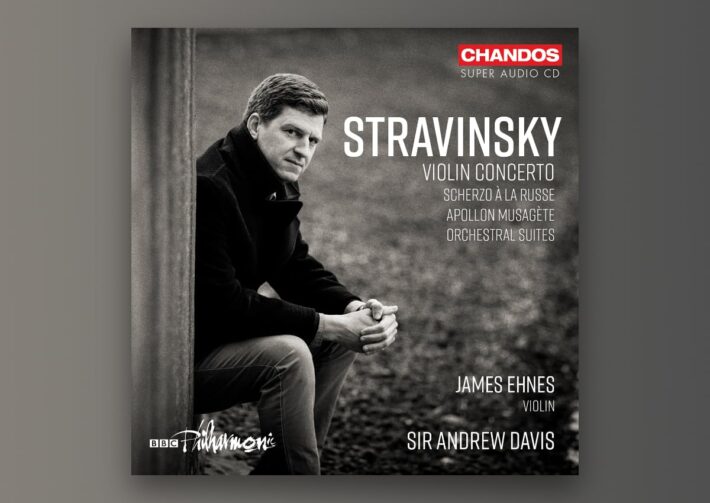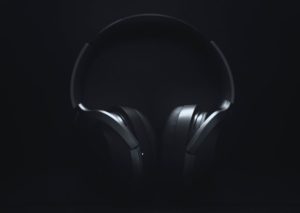This is James Ehnes and Sir Andrew Davis’ third collaboration on the Chandos label, and the initial glance at the all-Stravinsky track listing shows a balanced offering of a concerto, a ballet, and smaller orchestral pieces.
The Violin Concerto is somewhat reminiscent of its cousin, the Concerto for Winds, for its complex profile — a combination of assertive drive and elegant lyricism. The different layers of instrumentation in the Toccata (track 1) come through quite nicely, though I was bothered by the over-reverberation of the fine brass playing. However, this proved a minor flaw in light of the prevalent dance element to which Ehnes delivers a vivacious personality: at times, it is heavy and robust, even unapologetically sardonic but can also be coquettish and delicate. The changing orchestration is critical in these moments and the strings, brass, and wind groups don’t disappoint during their time in the spotlight.
With the constant rhythmic interplay and active dialogue central to the concerto, communication is a must. I found it on the whole impeccably done, and nowhere better than in the Aria I (track 3). The staccato runs across the violin and flute (a little past the 0’30”) are seamlessly synchronized as are the recurring syncopations between soloist and ensemble. Technicalities aside, there is an almost shrill clarity in Ehnes’ tone that evokes the aria’s disquietude.
Related Posts
- Review: Stravinsky – Symphony in C & Symphony in Three Movements – Sir Andrew Davis
- Review: Stravinsky – The Rite of Spring & The Firebird – Orchestre de Paris, Mäkelä
- Review: Ysaÿe – Six Sonatas for Violin Solo, Op. 27 – Hilary Hahn, Violin
The diverse spirit of the Capriccio (track 4) comes through at moments like 0’23”, where the husky and hearty violin theme is paired with chirpy commentary from high winds that wouldn’t be out of place in a ballet. Ehnes approaches his part with a confidence and optimism that suits the writing, but it’s his precision of articulation and steadfast tempo that adds a touch of boldness and even stubbornness. Staying true to the movement’s title, though, the performers avoid becoming too serious: the squelches and belches from the low brass at 1’20” add a welcome and comical twist.
As for the orchestral works, the martial Scherzo à la russe (track 5) should allow the brass its due moment—and I say “should” because while the blending of the instruments is solid, the aforementioned fuzzy tone still persists. A little more top voicing is needed, as we hear in the recordings by Simon Rattle/Birmingham (Warner) or even more clearly in Paavo Jarvi/Cincinnati (Telarc). Despite this, the larger scale contrast between sections is captured well: in the context of the denser, jovial G major section, the middle featuring the piano and scurrying strings is light and graceful.
I found the two Suites some of the most vibrant and well-performed works on the disc. The four vignettes of Suite No. 1 (orchestral arrangements of Stravinsky’s Five Easy Pieces for piano) are short, but the players make them vibrant and narrative. The Napoletana (track 7), for instance, has an infectious rhythmic lilt as it depicts a bustling Italian street. (I’d add here that the brass is wonderfully clear…which begs the question of why it wasn’t present in the other works?). We’re hit almost immediately with the fierce Española (track 8), whose bold string riffs and sharp winds evoke raw energy and urgency. The Marche of Suite No. 2 (track 10) is reminiscent of the composer’s ballets: we can hear the polytonal nod to Petrushka and the primal energy of Le Sacre du Printemps. The Polka (track 12) is all about off-kilter humor with some chaos thrown in; here, it’s evident that the instrumentalists—especially the clarinets—are enjoying the full minute of quirkiness.
As an example of Stravinsky’s neoclassicism, Apollon Musagète is a thoughtful choice especially when juxtaposed with the other selections. The rich blending and mellow textures of the opening Naisaance d’Apollon offer a promising enough interpretation, but I ended up not feeling as inspired as with other recordings. For instance, the violin solo in the second movement (track 14) is certainly eloquent but somewhat one-sided; hear how the soloist of the Karajan/Berlin Philharmonic (DG) offers much more in terms of expressive nuance. The Pas de Deux (track 21) has some of the tenderest moments of the ballet but I found the Chailly/Royal Concertgebouw account far more captivating in its finesse of colors.
Although established reference points remain primary recommendations with respect to some selections, I thought the Violin Concerto and the smaller orchestral works were especially convincing. It seems that Ehnes and Davis’ output has focused on the 20th century thus far, and I do look forward to seeing which composer they have in mind next.

Igor Stravinsky
Violin Concerto
Scherzo à la russe
Suites No. 1&2
Apollon musagète
James Ehnes – Violin
BBC Philharmonic
Sir Andrew Davis – Conductor
Chandos Records, Hybrid SACD 095115534021
Stravinsky Violin Concerto – Recommended Comparisons
Fuast | Perlman | Hahn | Vengerov
Included with an Apple Music subscription:
Read more classical music reviews or visit The Classic Review Amazon store
Follow Us and Comment:
[wd_hustle id=”HustlePostEmbed” type=”embedded”]












